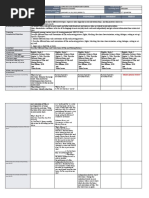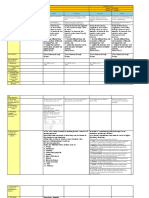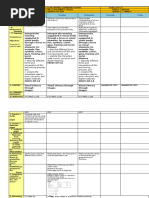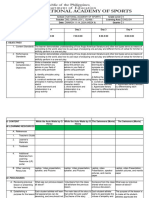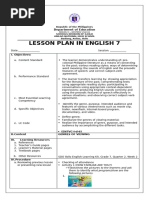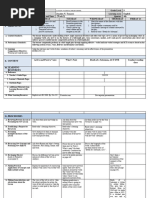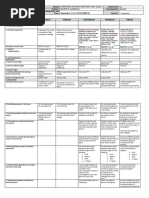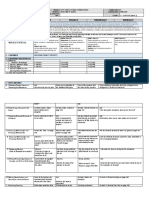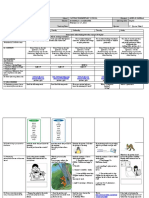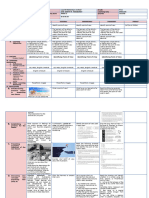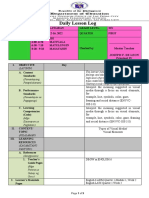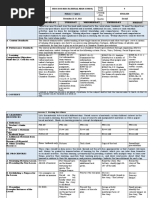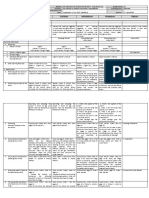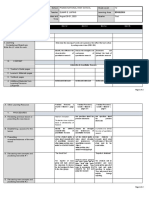DLL English SLM Based w9
DLL English SLM Based w9
Uploaded by
Jerwin Caba�ero (Lunduyan 2)Copyright:
Available Formats
DLL English SLM Based w9
DLL English SLM Based w9
Uploaded by
Jerwin Caba�ero (Lunduyan 2)Original Title
Copyright
Available Formats
Share this document
Did you find this document useful?
Is this content inappropriate?
Copyright:
Available Formats
DLL English SLM Based w9
DLL English SLM Based w9
Uploaded by
Jerwin Caba�ero (Lunduyan 2)Copyright:
Available Formats
School: LOMA DE GATO ELEMENTARY SCHOOL Grade Level: V
GRADES 1 to 12 Teacher: JERWIN E. CABANERO Learning Area: ENGLISH
DAILY LESSON LOG Teaching Dates and
Time: JANUARY 16-20, 2023 (WEEK 7) Quarter: 2ND QUARTER
MONDAY TUESDAY WEDNESDAY THURSDAY FRIDAY
I.OBJECTIVES
A.Content Standards The learner listens critically to different text types; expresses ideas logically in oral and written forms; and demonstrates interest in
reading to meet various needs.
B.Performance Standards The learner listens critically to news reports and other radio broadcasts and expresses ideas accurately in oral and in written
forms, demonstrates confidence in the use of the language to meet everyday needs; and reads independently and gets relevant information from various text
types.
C.Learning Distinguish among various types of viewing materials -EN5VC-Id-6
Competencies/Objectives Describe different forms and conventions of film and moving pictures (lights, blocking, direction characterization, acting, dialogue, setting or set-up).
Specific Objectives:
1. Identify different forms and conventions of film and moving pictures;
2. Describe different forms and conventions of film and moving pictures (lights, blocking, direction characterization, acting, dialogue, setting or set-
up); and
3. Appreciate a short film or story.
II.CONTENT Describe Different Forms and Convections of Film and Moving Pictures.
III.LEARNING RESOURCES
A.References English- Grade 5 English- Grade 5 English- Grade 5 English- Grade 5 English- Grade 5
1.Teacher’s Guide pages Alternative Delivery Mode Alternative Delivery Mode Alternative Delivery Mode Alternative Delivery Mode Alternative Delivery Mode
2.Learners’s Materials pages Quarter 2 – Title: Describe Quarter 2 – Title: Describe Quarter 2 – Title: Describe Quarter 2 – Title: Describe Quarter 2 – Title: Describe
3.Textbook pages Different Forms and Different Forms and Different Forms and Different Forms and Different Forms and
4.Additional materials from Conventions of Film and Conventions of Film and Conventions of Film and Conventions of Film and Conventions of Film and
learning resource (LR) portal Moving Pictures Moving Pictures Moving Pictures Moving Pictures Moving Pictures
First Edition, 2020 First Edition, 2020 First Edition, 2020 First Edition, 2020 First Edition, 2020
*ppt *ppt *ppt *ppt *ppt
*video lesson *video lesson *video lesson *video lesson *video lesson
B.Other Learning Resource
IV.PROCEDURES
A.Reviewing previous lesson or presenting What’s In? p.6 Review of previous Review of previous Review of previous SHORT QUIZ/ACTIVITY
the new lesson lesson/discussion lesson/discussion lesson/discussion
Directions: Examine the image
below. Then answer the
following questions based on
your viewpoint. Do this on your
answer sheet.
B.Establishing a purpose for the lesson What I Know? P.3-4 What is it? p.8
Directions: Identify what form A film also known as “movie”
or a “motion picture” is a series
and convention of film or of moving images shown on a
moving picture is being screen, usually with sound, that
described in each item. Write make up a story. It is a form of
the letter of the correct answer entertainment that enacts a story
by sound and a sequence of
in your answer sheet.
images giving the illusion of
continuous movement.
What’s New? P. 6-7
Directions: Read the story The Different Forms and
Shooting Conventions of Film and
by: Jean Paul V. Banay carefully Moving Pictures
and answer the following questions
below.
C.Presenting Examples/ instances of the new What’s More p. 9
lesson Independent Activity 1
Directions: Find the hidden
words relating to forms and
conventions of film in this word
puzzle. Draw a line to the word
you found to show your answer.
Do this on your answer sheet.
Independent Assessment 1
Directions: Write TRUE if the
statement is correct and FALSE
if not. Do this on your answer
sheet.
_____________1. In shooting a
film, use natural light only.
_____________2. Blocking is
the precise staging of actors in
order to facilitate
the performance of a film.
D.Discussing new concepts and practicing Independent Activity 2 p.12
new skills #1 Directions: Identify the forms
and conventions of film being
described by completing the
crossword puzzle using the clues
below. Do this on your answer
sheet.
E.Discussing new concepts and practicing Independent Activity 3 p.13
new skills #2
Directions: Change the
underlined words in each
sentence with a correct word
which describes the forms
and conventions of film. Use
the word clues as guide.
Write your answer on your
answer sheet.
F.Developing Mastery What I Have Learned p. 15
Directions: Identify the form
and conventions of film being
described. Write you answer
in your answer sheet.
______1. The scene happens
near the sea.
______2. The actress is
positioned in front of the
church.
______3. Coco Martin plays
as an action star.
G.Finding Practical application of concepts What I Can Do? P 15-16
and skills in daily living Directions: Write a sentence
describing the setting of the
following. Write you answer
in your answer sheet.
1. Lion King
2. Finding Nemo
3. Sponge Bob
H.Making generalization and abstraction What are the different form
about the lesson and convention of film?
I.Evaluating learning Assessment p. 16-17
Directions: Identify what
form and convention of film
or moving picture is being
described. Write the letter of
the correct answer in your
answer sheet.
J.additional activities for application or Additional Activities p.17
remediation Directions: Think of a film
that you would recommend
to your friends or classmates.
Describe the lighting,
characterization, dialogue
and share why this film is
worth watching. Do this on
your answer sheet. (10
points)
V.REMARKS
VI.REFLECTION
A.No. of learners who earned 80% in the
evaluation
B.No.of learners who require additional activities
for remediation
C.Did the remedial work? No.of learners who have ___ of Learners who earned 80% above ___ of Learners who earned 80% above ___ of Learners who earned 80% above ___ of Learners who earned 80% above ___ of Learners who earned 80% above
caught up with the lesson
D.No. of learners who continue to require ___ of Learners who require additional activities ___ of Learners who require additional ___ of Learners who require additional ___ of Learners who require additional ___ of Learners who require additional
remediation for remediation activities for remediation activities for remediation activities for remediation activities for remediation
E.Which of my teaching strategies worked well? ___Yes ___No ___Yes ___No ___Yes ___No ___Yes ___No ___Yes ___No
Why did these work? ____ of Learners who caught up the lesson ____ of Learners who caught up the lesson ____ of Learners who caught up the lesson ____ of Learners who caught up the ____ of Learners who caught up the
lesson lesson
F.What difficulties did I encounter which my ___ of Learners who continue to require ___ of Learners who continue to require ___ of Learners who continue to require ___ of Learners who continue to require ___ of Learners who continue to require
principal or supervisor can helpme solve? remediation remediation remediation remediation remediation
G.What innovation or localized materials did Strategies used that work well: Strategies used that work well: Strategies used that work well: Strategies used that work well: Strategies used that work well:
used/discover which I wish to share with other
• ___Metacognitive Development: Examples: Self • ___Metacognitive Development: Examples: • ___Metacognitive Development: Examples: • ___Metacognitive •
Development: ___Metacognitive Development:
teachers? assessments, note taking and studying Self assessments, note taking and studying Self assessments, note taking and studying Examples: Self assessments, note taking Examples: Self assessments, note taking
techniques, and vocabulary assignments. techniques, and vocabulary assignments. techniques, and vocabulary assignments. and studying techniques, and vocabulary and studying techniques, and vocabulary
• ___Bridging: Examples: Think-pair-share, quick-• ___Bridging: Examples: Think-pair-share, • ___Bridging: Examples: Think-pair-share, assignments. assignments.
writes, and anticipatory charts. quick-writes, and anticipatory charts. quick-writes, and anticipatory charts. • •
___Bridging: Examples: Think-pair-share, ___Bridging:Examples:Think-pair-
• ___Schema-Building: Examples: Compare and • ___Schema-Building: Examples: Compare and • ___Schema-Building: Examples: Compare and quick-writes, and anticipatory charts. share,quick-writes,andanticipatorycharts.
contrast, jigsaw learning, peer teaching, and contrast, jigsaw learning, peer teaching, and •
contrast, jigsaw learning, peer teaching, and ___Schema-Building: Examples: Compare • __Schema-Building: Examples: Compare
projects. projects. projects. and contrast, jigsaw learning, peer and contrast, jigsaw learning, peer
• ___Contextualization: • ___Contextualization: • ___Contextualization: teaching, and projects. teaching, and projects.
• Examples: Demonstrations, •
media, Examples: Demonstrations, •
media, Examples: Demonstrations, •
media, ___Contextualization: • ___Contextualization:
manipulatives, repetition, and local manipulatives, repetition, and local manipulatives, repetition, and •
local Examples: Demonstrations, •
media, Examples: Demonstrations, media,
opportunities. opportunities. opportunities. manipulatives, repetition, and local manipulatives, repetition, and local
• ___Text Representation: • ___Text Representation: • ___Text Representation: opportunities. opportunities.
• Examples: Student created drawings, videos, and• Examples: Student created drawings, videos,• Examples: Student created drawings, videos,• ___Text Representation: • ___Text Representation:
games. and games. and games. • Examples: Student created drawings, • Examples: Student created drawings,
• ___Modeling: Examples: Speaking slowly and • ___Modeling: Examples: Speaking slowly and • ___Modeling: Examples: Speaking slowly and videos, and games. videos, and games.
clearly, modeling the language you want students clearly, modeling the language you want clearly, modeling the language you want • ___Modeling: Examples: Speaking slowly • ___Modeling: Examples: Speaking slowly
to use, and providing samples of student work. students to use, and providing samples of students to use, and providing samples of and clearly, modeling the language you and clearly, modeling the language you
Other Techniques and Strategies used: student work. student work. want students to use, and providing want students to use, and providing
___ Explicit Teaching Other Techniques and Strategies used: Other Techniques and Strategies used: samples of student work. samples of student work.
___ Group collaboration ___ Explicit Teaching ___ Explicit Teaching Other Techniques and Strategies used: Other Techniques and Strategies used:
___Gamification/Learning throuh play ___ Group collaboration ___ Group collaboration ___ Explicit Teaching ___ Explicit Teaching
___ Answering preliminary ___Gamification/Learning throuh play ___Gamification/Learning throuh play ___ Group collaboration ___ Group collaboration
activities/exercises ___ Answering preliminary ___ Answering preliminary ___Gamification/Learning throuh play ___Gamification/Learning throuh play
___ Carousel activities/exercises activities/exercises ___ Answering preliminary ___ Answering preliminary
___ Diads ___ Carousel ___ Carousel activities/exercises activities/exercises
___ Differentiated Instruction ___ Diads ___ Diads ___ Carousel ___ Carousel
___ Role Playing/Drama ___ Differentiated Instruction ___ Differentiated Instruction ___ Diads ___ Diads
___ Discovery Method ___ Role Playing/Drama ___ Role Playing/Drama ___ Differentiated Instruction ___ Differentiated Instruction
___ Lecture Method ___ Discovery Method ___ Discovery Method ___ Role Playing/Drama ___ Role Playing/Drama
Why? ___ Lecture Method ___ Lecture Method ___ Discovery Method ___ Discovery Method
___ Complete IMs Why? Why? ___ Lecture Method ___ Lecture Method
___ Availability of Materials ___ Complete IMs ___ Complete IMs Why? Why?
___ Pupils’ eagerness to learn ___ Availability of Materials ___ Availability of Materials ___ Complete IMs ___ Complete IMs
___ Group member’s ___ Pupils’ eagerness to learn ___ Pupils’ eagerness to learn ___ Availability of Materials ___ Availability of Materials
collaboration/cooperation ___ Group member’s ___ Group member’s ___ Pupils’ eagerness to learn ___ Pupils’ eagerness to learn
in doing their tasks collaboration/cooperation collaboration/cooperation ___ Group member’s ___ Group member’s
___ Audio Visual Presentation in doing their tasks in doing their tasks collaboration/cooperation collaboration/cooperation
of the lesson ___ Audio Visual Presentation ___ Audio Visual Presentation in doing their tasks in doing their tasks
of the lesson of the lesson ___ Audio Visual Presentation ___Audio Visual Presentation
of the lesson of the lesson
PREPARED BY: CHECKED BY: NOTED BY:
JERWIN E. CABANERO ANGELO B. DATING ROSALINDA G. GABRIEL
TEACHER III Master Teacher I Principal IV
You might also like
- Essential Korean Idioms: 300 Idioms to upgrade your KoreanFrom EverandEssential Korean Idioms: 300 Idioms to upgrade your KoreanRating: 4 out of 5 stars4/5 (11)
- BFS1001 - Session 2 - Resume Templates To Help You For Your Assignment - Uploaded Onto IVLEDocument3 pagesBFS1001 - Session 2 - Resume Templates To Help You For Your Assignment - Uploaded Onto IVLEJavier ThooNo ratings yet
- ASQ Realtests CMQ-OE v2015-03-27 by Irma 150q PDFDocument68 pagesASQ Realtests CMQ-OE v2015-03-27 by Irma 150q PDFKabala UsmanNo ratings yet
- Thesis - Mental HealthDocument271 pagesThesis - Mental HealthDavid LockeridgeNo ratings yet
- Final Rejoinder Notice-MERCDocument15 pagesFinal Rejoinder Notice-MERCS Lal Vaswani100% (1)
- DLL English SLM Based w9Document5 pagesDLL English SLM Based w9Jerwin Caba�ero (Lunduyan 2)No ratings yet
- WEEK2 DLL ENGLISHDocument6 pagesWEEK2 DLL ENGLISHJaniceNo ratings yet
- Week2 DLL EnglishDocument7 pagesWeek2 DLL EnglishLLOYD JEMAR DOCOGNo ratings yet
- DLL - English 5 - Q1 - W5Document5 pagesDLL - English 5 - Q1 - W5Allan CasinilloNo ratings yet
- Convention of Film LightDocument6 pagesConvention of Film LightGENELYN GAWARAN50% (2)
- LE in English 7 (Q1-W2)Document2 pagesLE in English 7 (Q1-W2)Chiclette GanganNo ratings yet
- English 7 - DLL Q1W3Document3 pagesEnglish 7 - DLL Q1W3Vince GomezNo ratings yet
- 2daily Lesson Log in English 7Document8 pages2daily Lesson Log in English 7Norbelle Lou100% (1)
- Describing Forms and Conventions of Film: Bongabon Central School K To 12 Curriculum Daily Lesson LogDocument3 pagesDescribing Forms and Conventions of Film: Bongabon Central School K To 12 Curriculum Daily Lesson LogJoan PeridaNo ratings yet
- WEEK2 DLL ENGLISHDocument8 pagesWEEK2 DLL ENGLISHnikka dela rosaNo ratings yet
- WEEK2-dll-ENGLISH 6Document6 pagesWEEK2-dll-ENGLISH 6kielrocks12No ratings yet
- English 6 1 1Document2 pagesEnglish 6 1 1dionisioNo ratings yet
- Holiday: En7V-Iib: En7Wc-Iib: En7Wc-Iib: Envc-IibDocument3 pagesHoliday: En7V-Iib: En7Wc-Iib: En7Wc-Iib: Envc-IibSumugat TricyNo ratings yet
- W5-Q2-DLL-ENGLSIH-5Document5 pagesW5-Q2-DLL-ENGLSIH-5Glaiza FigueroaNo ratings yet
- English6 Week 4Document9 pagesEnglish6 Week 4GENELYN GAWARANNo ratings yet
- DLL Eng9 3RD QRT 6WKDocument7 pagesDLL Eng9 3RD QRT 6WKnas.eirikajoyguiamNo ratings yet
- Dll English 6 Wk7 q1Document8 pagesDll English 6 Wk7 q1Myka Andrea Panganiban GarciaNo ratings yet
- DLL English 5 q2 w10Document4 pagesDLL English 5 q2 w10Jonnalyn ArcinasNo ratings yet
- For COTDocument4 pagesFor COTROSANNE CERBASNo ratings yet
- School: Grade Level: Teacher: Learning Area: Teaching Dates and Time: QuarterDocument3 pagesSchool: Grade Level: Teacher: Learning Area: Teaching Dates and Time: Quarterjonalyn tamayoNo ratings yet
- DLL Eng 10 April 17-19Document5 pagesDLL Eng 10 April 17-19Mark Jayson BacligNo ratings yet
- G5 Q4W1 DLL ENGLISH (MELCs)Document10 pagesG5 Q4W1 DLL ENGLISH (MELCs)maricel porteNo ratings yet
- Genre - Week 3Document5 pagesGenre - Week 3Randy R. SalidagaNo ratings yet
- DLL English-3 Q1 Week-1Document6 pagesDLL English-3 Q1 Week-1Fatima LopenaNo ratings yet
- I. Objectives Monday Tuesday Wednesday ThursdayDocument33 pagesI. Objectives Monday Tuesday Wednesday ThursdayJed GalvezNo ratings yet
- DLL - English 3 - Q1 - W1Document3 pagesDLL - English 3 - Q1 - W1Kay-Arvee NatividadNo ratings yet
- DLL - ENGLISH 6 - Q1September 5 To 9 FinalDocument4 pagesDLL - ENGLISH 6 - Q1September 5 To 9 FinalHoneyline Dado Depra100% (1)
- DLL English-3 Q3 W1Document3 pagesDLL English-3 Q3 W1Marita bagaslaoNo ratings yet
- DLL_ENGLISH 3_Q1_W2Document3 pagesDLL_ENGLISH 3_Q1_W2marilou mingoNo ratings yet
- DLL - English 6 - Q4 - W3Document4 pagesDLL - English 6 - Q4 - W3Rosemarie GonzagaNo ratings yet
- DLL - English 5 - Q4 - W5Document3 pagesDLL - English 5 - Q4 - W5CHERRY RIVERANo ratings yet
- Q3W1 DLL EnglishDocument8 pagesQ3W1 DLL EnglishNenita CaalimNo ratings yet
- DLL-ENGLISH-2-Q2-Week-3-SY-24-25Document8 pagesDLL-ENGLISH-2-Q2-Week-3-SY-24-25Cinderella MateoNo ratings yet
- DLL English Q2 W1Document4 pagesDLL English Q2 W1Wiljohn ComendadorNo ratings yet
- DLL W5 Q2 Englsih 5Document7 pagesDLL W5 Q2 Englsih 5Zoe Seyer TahubgamNo ratings yet
- DLL Eng 7Document9 pagesDLL Eng 7calixtojr.candoleNo ratings yet
- English 10 First Quarter Week 3Document4 pagesEnglish 10 First Quarter Week 3Vince Rayos Cailing100% (3)
- DLL - English 5 - Q2 - W4Document6 pagesDLL - English 5 - Q2 - W4REIANA MITZI M. FernandezNo ratings yet
- English Q1 Week 2Document9 pagesEnglish Q1 Week 2GENELYN GAWARANNo ratings yet
- DLP Sept 12 ENGDocument4 pagesDLP Sept 12 ENGJoi FainaNo ratings yet
- DLL ENGLISH 10 Week3 2023 2024Document8 pagesDLL ENGLISH 10 Week3 2023 2024Beverly Roque Madayag - Nacino100% (1)
- English 7 Daily Lesson Log THIRD QUARTER Week 7Document4 pagesEnglish 7 Daily Lesson Log THIRD QUARTER Week 7VINCENT CAILINGNo ratings yet
- DLL English Grade 6 Week 4 Quarter 4Document11 pagesDLL English Grade 6 Week 4 Quarter 4IamCcj100% (2)
- DLL - ENGLISH 3 - Q2 - C2 - Verbs Past Present Future@edumaymayDocument7 pagesDLL - ENGLISH 3 - Q2 - C2 - Verbs Past Present Future@edumaymayjimNo ratings yet
- Week 3 Quarter 2Document3 pagesWeek 3 Quarter 2EJ EscobilloNo ratings yet
- DLL Week 3Document4 pagesDLL Week 3Mia Lei LalantaconNo ratings yet
- School Grade Level Teacher Learning Area Teaching Dates and Time QuarterDocument5 pagesSchool Grade Level Teacher Learning Area Teaching Dates and Time QuarterMelany SiasatNo ratings yet
- DLL - ENGLISH 6 - Q1 September 12 To 16 FinalDocument4 pagesDLL - ENGLISH 6 - Q1 September 12 To 16 FinalHoneyline Dado DepraNo ratings yet
- DLL_ENGLISH 3_Q1_W3Document4 pagesDLL_ENGLISH 3_Q1_W3marilou mingoNo ratings yet
- DLL English 9Document2 pagesDLL English 9celinejoi pajarillagaNo ratings yet
- DLL-WEEK-2-SEP-25-29 Melc 3Document5 pagesDLL-WEEK-2-SEP-25-29 Melc 3Erica QuizaNo ratings yet
- WEEK2 DLL ENGLISHDocument4 pagesWEEK2 DLL ENGLISHHanna BuadaNo ratings yet
- Daily LessonDocument5 pagesDaily LessonElmar Enoc LapingNo ratings yet
- MELC-BASED-DLL-QUARTER-1-WEEK-5 (1)Document20 pagesMELC-BASED-DLL-QUARTER-1-WEEK-5 (1)Arlene Hernandez-MañiboNo ratings yet
- DLL - English 3 - Q1 - W2Document3 pagesDLL - English 3 - Q1 - W2Rose Dagdag-LaguitaoNo ratings yet
- Week 1 Eng6Document14 pagesWeek 1 Eng6TRICIA DIZONNo ratings yet
- ENG - Q1 W3 Sept 5-9Document3 pagesENG - Q1 W3 Sept 5-9IMELDA GUARINNo ratings yet
- Grammar Practice Simplified: Guided Practice in Basic Skills (Book A, Grades 2-3): Nouns, Verbs, Capital Letters, Periods, Question Marks, and MoreFrom EverandGrammar Practice Simplified: Guided Practice in Basic Skills (Book A, Grades 2-3): Nouns, Verbs, Capital Letters, Periods, Question Marks, and MoreNo ratings yet
- Teaching English to Young Learners: Teacher DevelopmentFrom EverandTeaching English to Young Learners: Teacher DevelopmentRating: 4 out of 5 stars4/5 (5)
- w07 Chapter 6 Questions Emily PopocaDocument2 pagesw07 Chapter 6 Questions Emily Popocaapi-518483960No ratings yet
- CJR Semiotic Sara Claresti NewDocument10 pagesCJR Semiotic Sara Claresti NewyosevinNo ratings yet
- Guay Resume 2021Document2 pagesGuay Resume 2021api-490671856No ratings yet
- Level 3 Certificate in Supporting Individuals With Learning Disabilities UnitsDocument5 pagesLevel 3 Certificate in Supporting Individuals With Learning Disabilities UnitsIustin MargineanuNo ratings yet
- Engla210 ReportDocument2 pagesEngla210 Reportohood781No ratings yet
- 3rd Chapter Career Aspects in Physical EducationDocument3 pages3rd Chapter Career Aspects in Physical Educationmondalsuparna2006No ratings yet
- Spanish ArchitectureDocument14 pagesSpanish ArchitectureCliff Jason GulmaticoNo ratings yet
- 4 Year Graduation PlanDocument5 pages4 Year Graduation Planapi-357381234No ratings yet
- INTRAC NGOs Impact AssessmentDocument8 pagesINTRAC NGOs Impact AssessmentHardik ChawlaNo ratings yet
- Body Awareness PDFDocument4 pagesBody Awareness PDFDaniel TakNo ratings yet
- AparDocument29 pagesAparChellappa Gangadhar KNo ratings yet
- Tam Tutorial LetterDocument14 pagesTam Tutorial LetterSiwe NhlapoNo ratings yet
- Case Study of A Problem-Based Bridge Engineering Design CourseDocument6 pagesCase Study of A Problem-Based Bridge Engineering Design CourseJashwin UllalNo ratings yet
- Brian Street, Dave Baker, Alison Tomlin (Eds.) - Navigating Numeracies - Home - School Numeracy Practices (2005, Springer) (10.1007!1!4020-3677-9) - Libgen - LiDocument229 pagesBrian Street, Dave Baker, Alison Tomlin (Eds.) - Navigating Numeracies - Home - School Numeracy Practices (2005, Springer) (10.1007!1!4020-3677-9) - Libgen - LiITU2No ratings yet
- Reflection:: Name of Discussant: Course: Subject: Name of ProfessorDocument2 pagesReflection:: Name of Discussant: Course: Subject: Name of ProfessorJewel GuintoNo ratings yet
- Direct-Instruction ModelDocument1 pageDirect-Instruction Modelapi-225717058No ratings yet
- Why Do We Study LiteratureDocument10 pagesWhy Do We Study Literatureangelica suriagaNo ratings yet
- Activity 3: Activity 4: Filipino Scientists and Their Contributions To Science and TechnologyDocument4 pagesActivity 3: Activity 4: Filipino Scientists and Their Contributions To Science and TechnologyJeya Plays YT100% (1)
- 2021 School Based Inset Proposal-JrcmDocument6 pages2021 School Based Inset Proposal-JrcmJOE RALPH MABBORANG100% (1)
- Benefits of VideogamesDocument5 pagesBenefits of Videogamesapi-280696218No ratings yet
- Application Form Divional Public School Chamalang Cheme 2014.pDocument2 pagesApplication Form Divional Public School Chamalang Cheme 2014.pSyed Sami Ullah ShahNo ratings yet
- Poulami Ghosh: JOB OBJECTIVE: Willing To Work As A Key Player in Challenging and Creative Environment &Document1 pagePoulami Ghosh: JOB OBJECTIVE: Willing To Work As A Key Player in Challenging and Creative Environment &Poulami GhoshNo ratings yet
- Current Affairs 2014 PDFDocument4 pagesCurrent Affairs 2014 PDFSultan AhmedNo ratings yet
- Principles of Critical Thinking - Lawrence BlandDocument3 pagesPrinciples of Critical Thinking - Lawrence BlandYuvraj Parmar D Y PATIL INTERNATIONAL SCHOOL PUNE100% (1)
- Au PDFDocument3 pagesAu PDFJohn JuliusNo ratings yet
- Music As A LanguageDocument2 pagesMusic As A LanguageCley VelázquezNo ratings yet





